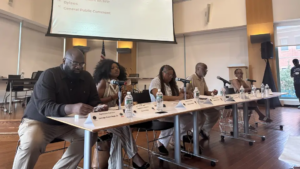We rely on fresh water for drinking, food, and sanitation, and they’re in trouble. But freshwater issues are becoming a higher priority for conservationists.
When Grand Canyon National Park was established a century ago, the Colorado River running through it was treated as an afterthought. In the decades following, states scrambled to squeeze every drop of water out of the Colorado for farming and drinking, with a cascade of huge dams constructed along its course.
Native fish like suckers and chubs, found nowhere else in the world, were replaced with invasive catfish and bass that were more attractive for anglers. In time, the mighty river that had once carved out one of America’s most iconic landscapes was reduced to a trickle, no longer able to fulfill its destiny of reaching the sea.
What happened to the Colorado is a powerful example of a river’s decline, but it’s hardly an exception. Around the world, rivers, lakes, and wetlands have increasingly come under similar assault from poorly planned dams, pollution, habitat loss, sand mining, climate change, and the introduction of invasive species.
The result, as laid out this week in a report by 16 conservation organizations, is that freshwater ecosystems have become the most degraded in the world, with fish populations pushed to the brink. There are more kinds of freshwater fish—18,075 and counting—than there are fish species living in the oceans and seas. Freshwater vertebrate populations have declined by 86 percent since 1970—twice the rate experienced within terrestrial or marine ecosystems—and almost a third of freshwater fish species are now threatened with extinction.
Yet it’s a crisis that has received far less attention than other environmental emergencies—like deforestation or plastic pollution—despite human reliance on freshwater systems for drinking water, food, and sanitation. As for river protection, it has long been seen as part of terrestrial protection; protect the land and you’ll protect the river that runs through it, the thinking has been, even though overwhelming evidence suggests that such an approach generally does not work.
But now there are signs of change, with freshwater issues becoming more prominently featured on the conservation agenda. While a steady release of studies continue to expose the sorry state of affairs, the ecological and economic benefits of maintaining healthy rivers are increasingly clear, scientists say, as are the solutions for how to do it. They warn, however, that things need to move fast if we are going to save ecosystems crucial to the survival of both animals and humans.
“Humanity is intimately tied to the health of freshwater ecosystems,” says Kathy Hughes, a freshwater specialist with the World Wildlife Fund in the United Kingdom, and the lead author of the new report. “Freshwater biodiversity is our canary in the mine and if freshwater ecosystems can no longer support thriving biodiversity, then it’s a sure sign that they’re not good for humanity either.”
YEAR OF THE RIVER
Historically, protected areas have been designed for terrestrial ecosystems and their species, with little, if any, consideration given to the freshwater habitats in them. This is in part because of the complexity of rivers, which can flow into and out of protected or managed areas, through different landscapes and sometimes even countries.
“It’s a lot easier to draw a line around a piece of land or in the ocean than it is to do it for a river,” says John Zablocki, a biodiversity expert with the Nature Conservancy who spearheads an international network of freshwater scientists devising new ways of thinking about river protection.
He points out that rivers that run through protected land areas are often not protected from upstream impacts, something that was starkly illustrated in a study published in Conservation Letters last year. It showed that there are 1,249 large dams located inside protected areas, and more than 500 dams planned or under construction within protected areas worldwide.
“We have to get away from thinking about land first and rivers second,” says Zablocki, whose organization is working with multiple municipalities in the Western Balkan nation of Montenegro, where the government recently designated the lower reaches of the highly biodiverse Zeta River as a nature park.
Another movement is focused on providing legal protection for rivers. In 2017, New Zealand became the first country to grant a specific river legal rights the same as those of humans, meaning that in a court of law, they’re treated like living entities. Since then, Bangladesh has done the same with all of its rivers, while the city of Toledo, Ohio, passed what’s known as the Lake Erie Bill of Rights to protect its shores, making it one of several cities in the United States to pass legislation recognizing the rights of nature.
“We’re going to need a multi-tiered approach to keep rivers healthy and free-flowing,” says Michele Thieme, the lead freshwater scientist at the World Wildlife Fund in the United States. “There’s not going to be one silver bullet.”
With freshwater scientists hoping that 2021 could be the year of the river, some influential conservationists who have previously not focused on freshwater issues may be taking a keener interest, including the Campaign for Nature, the $1 billion initiative funded by Switzerland’s Wyss Foundation and supported by the National Geographic Society, which aims to conserve 30 percent of the planet in a natural state by 2030.
The campaign specifically targets lands and oceans, without mentioning rivers. But that could soon be changing, according to its director, Brian O’Donnell. “All the reports describing the freshwater biodiversity crisis have provided a wake-up call for us and made it clear that explicit representation of freshwater areas needs to be part of the equation going forward,” O’Donnell says.
DEVASTATING LOSS
While fresh water makes up less than one percent of Earth’s flowing water, it is home to 10 percent of all known species, including a third of all vertebrates.
Among the more unusual freshwater varieties are Africa’s elephant fishes, which communicate through electrical signals, and the Amazon’s spraying characins, which lay their eggs on land. Freshwater systems are also home to around 270 species of turtles, more than 1,300 species of crabs, and around 5,700 species of dragonflies.
Conservationists say at least 80 freshwater fish species have gone extinct since counts were first taken, and 16 in the last year alone. The real number of extinctions, however, is certain to be much higher, since threats to fish are growing and many species are poorly monitored.
Perhaps most shocking is the loss of “mega-fishes”—so called because of their enormous size—whose populations have declined by 94 percent since 1970, including many species of now-critically endangered sturgeon.
Also cited in the report are recent studies showing that only one-third of large rivers in the world remain free-flowing—meaning they have not been dammed or disrupted by humans—and that wetlands have declined globally by nearly 70 percent since 1900, three times the rate of forests.
“This almost inconceivable loss has occurred largely within our lifetime,” Hughes says.
A study published in Science last week showed that rivers in which fish populations have escaped serious damage from human activities now make up just 14 percent of the world’s river basins, with western Europe and North America worst off.
The lead author of that study, Guohuan Su of the University of Toulouse in France, notes that almost all of us live in river basins, since all of Earth’s land mass— excluding some deserts where it never rains and the poles—are part of river basins. “You could say we live in the arms of the rivers, and we’re cutting them off,” he says.
Many conservationists maintain that political and economic motives routinely trump biodiversity concerns when it comes to decision-making about rivers. “Very rarely is the full value of ecosystems factored into the planning for dams, for example,” says Ian Harrison, a freshwater specialist with Conservation International, and a contributor to the report released this week.
Increasingly, research shows that taking into account fisheries and the ecological health of rivers is good business, says Denielle Perry, a water resource geographer at Northern Arizona University in Flagstaff. “Protecting rivers is a low-cost investment with a high return, especially when you consider the ecosystem services they provide for free.”
One reason freshwater fisheries receive less attention than their marine counterparts may be because they are concentrated in low-income countries that may not be considered important because they don’t export much fish. Just 16 nations, mostly in Asia and Africa, account for 80 percent of the world’s reported wild freshwater catch of 12 million tons per year, though that total is likely to be vastly underestimated, since many catches by subsistence fishers in countries from Congo to Cambodia are not documented.
For at least 200 million people around the world, freshwater fish provide their primary source of animal protein, according to the new report.
These fish may also be hampered by an image problem. While big, charismatic animals on land and in the oceans have attracted conservation resources, few freshwater fish have garnered the same attention.
“We can see and appreciate the way a gorilla cares for its young or marine turtles come up on the beach to lay their eggs, but we don’t have that connection with freshwater fish, which often live in murky rivers out of sight,” says Zeb Hogan, a fish biologist at the University of Nevada, Reno, and a National Geographic Explorer.
Hogan, who leads a USAID-sponsored research project called Wonders of the Mekong, has worked in Southeast Asia’s Mekong region for more than 20 years. He has witnessed the near disappearance of some of the world’s largest freshwater fishes, including the Mekong giant catfish and giant barb, along with the continuous deterioration of the river, which originates on the Tibetan Plateau and runs through six countries before emptying into the South China Sea.
In the last couple of years, the decline appears to have accelerated, with Mekong water levels dropping to historic lows, threatening fish and the livelihoods of many of the 60 million people living along the river. The situation, observers say, has been caused in large part by Chinese dams built in the upper watershed, which sometimes withhold the water critical for fish to complete their lifecycles downstream, as well as drought exacerbated by climate change.
Those developments have forced at least some decision-makers into rethinking their development plans. Cambodia, for example, late last year announced a 10-year moratorium on the building of new dams on the main part of the Mekong.
Freshwater scientists say the UN Convention on Biological Diversity conference, scheduled for this fall in Kunming, China, must produce a new global biodiversity agreement that pays as much attention to protecting and restoring the world’s rivers, lakes, and wetlands as its forests and oceans.
“Now is the decision point,” says Harrison, of Conservation International. “If we don’t make the right investments for our freshwater ecosystems, it’s going to be too late. The ship will have sailed, and we won’t be able to turn around.”




